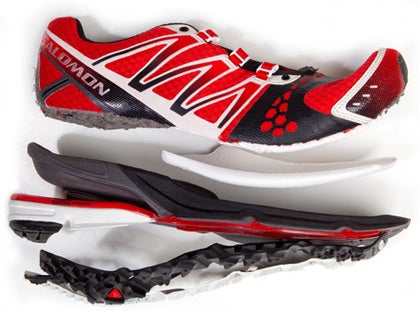New perk! Get after it with local recommendations just for you. Discover nearby events, routes out your door, and hidden gems when you sign up for the Local Running Drop.
The anatomy of a trail shoe and how to select the best fit
As a result of our sport’s simplicity, it is essential to choose carefully when it comes to that one piece of equipment—shoes.

Photo by Jolene Melnicoff
As a result of our sport’s simplicity, it is essential to choose carefully when it comes to that one piece of equipment—shoes. Navigating the shoe wall of a running specialty shop can be a daunting task. Several recent studies at the University of Calgary, however, make the process slightly more straightforward, suggesting that runners tend to be more economical and less injury prone when they run in the shoes that simply feel the most comfortable.
Explains Rolando Cruz, a manager at Berkeley Running Company in Madison, Wisconsin. “You might have a vision of what works for you, but when you try on other shoes, you may find that certain features are more important than you originally thought.”
As you begin your journey into the footwear jungle, keep comfort in mind, but also consider biomechanics, injury history and the terrain you will be running.
Weight
The rule of thumb, is to get just enough shoe for the job. “The weight of the shoe increases the energy cost of running,” explains Dr. Paul Langer, a Podiatrist and Clinic Advisory Board Member for the American Running Association. “More weight makes us work harder to run.”
For rocky and rutted trails, Dr. Langer advises against barefoot or minimalist footwear. “It just doesn’t offer enough protection,” he says. All-around shoes generally weigh between 10 and 12 ounces.
Outsole
While some trail-running shoes have aggressive, claw-like lug patterns, others are barely decipherable from a road shoe. Consider terrain and weather conditions when selecting an outsole. “You will want a lot of traction for going downhill, especially if the trails are muddy and wet,” says Cruz. And suggests Anne Crocker, a manager at Runners Roost in Denver, Colorado, “On the most rugged terrain, a rock plate protects your feet.”
Check out the depth and placement of the lugs. Deeper tread, especially in the forefoot region, offers the best grip on steep, muddy and rocky trails, while more modest tread is adequate for smoother surfaces.
Midsole
The midsole of a trail-running shoe is where all the support and cushioning lives. Although trails can be more difficult to negotiate than pavement, look to decrease the amount of stability and support compared to your road shoes, Says Dr. Langer, “You want your foot to adapt to the terrain.”
Too much cushioning and support reduces your ability to sense trail irregularities, translating into ankle wobble as your foot overpronates and supinates. “We are finding that the more flexible the shoe is, the more control a trail runner has,” explains Cruz. A trail shoe with a thinner yet still protective midsole allows you to feel what is underfoot, giving you the chance to adapt to uneven terrain.
Upper
Some trail shoes have a thin mesh upper, while others sport more protective materials. “The majority of trail-running shoes have a weather-proof upper with a tight weave to keep out debris,” says Crocker. If you are going to be negotiating sticks, stones and brush, select a shoe with a more substantial upper. And there is nothing worse than blisters caused by puddle-soaked feet—for wet climates, consider a waterproof-breathable upper.
In hot and dry conditions, says Crocker, “You want a breathable mesh upper so your feet don’t get hot, increasing the likelihood of blisters.”
Overall Fit
Trail shoes should fit closely in the heel and the midfoot for support on uneven surfaces. “You want that snug midfoot feel because you will blister quickly if the shoe is too loose,” says Dr. Langer.
In the front of the shoe, there should be about a thumb’s width of space. Width-wise your foot should lie flat without pinching along the sides. When your feet swell on longer runs, you will be glad to have the extra room.
Foot typology
Bring your old shoes into your local running specialty store so an expert can examine the wear pattern and watch you walk, run and discuss your injury history. To get started, consider your foot type:
Flat Feet. Runners with flat or fallen arches tend to have more flexible feet and usually overpronate. Consider a shoe with arch support and stability.
Normal Arches. Most runners fall into this category. These individuals have normal arches and overpronate slightly. Pick a neutral shoe to allow for a natural stride.
High Arches. High arches mean rigid feet. Stay away from stiff shoes. Choose a flexible shoe with good cushioning.